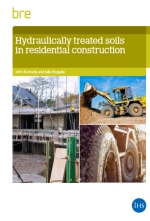Hydraulically treated soils in residential construction (BR 513)
BRE (Building Research Establishment) is an independent, research-based consultancy, testing and training organisation, operating in the built environment and associated industries.
On 5 April 2017, BRE published Hydraulically treated soils in residential construction (BR 513) written by John Kennedy and Julie Bregulla.
The 58 page publication focuses on soil treatment for residential construction, providing information on the technical issues to be considered when considering the use of soil treatment.
The soil treatment described in the guide refers to the process of using lime, cement, ground granulated blastfurnace slag (ggbs) and coal fly ash to render mainly wet natural or reworked natural soils suitable for use as engineered fill. Typically, the treatment alters the properties of the soil by removing free or excess water so that it can support foundations, ground floors, services and other infrastructure without excessive deformation.
Soil treatment has been a common process in road and airport construction in the UK since the 1970s, but its use in residential applications has been relatively limited.
BR 513 will help to inform developers, engineers and other building professionals wanting to learn more about soil treatment and its application, and suggests a regime of validation and testing to review the suitability and appropriateness of the technique.
The processes described use the traditional technique of in situ soil treatment to produce successive horizontal layers of treated soil. Other techniques that use deep column mixing or injection techniques applied vertically are not covered.
The contents of the guide include:
- Overview
- Background
- Purpose and objectives
- Part 2: Principles of soil treatment
- History
- The basis of soil treatment
- Current guidance and specifications for soil treatment in highways
- Experience of hydraulically treated fill for housing
- Overview
- Soils and treating agents: suitability and compatibility
- Suggested design protocol for housing
- Suggested laboratory design process for housing
- Site investigation to establish soil characteristics and suitability
- Construction
- Laboratory mixture design
- Construction control
- Verification of treatment
- Ancillaries
- References and bibliography
- Part 5: Appendices
- Hydraulically treated soil projects where expansion occurred
- Highways England protocol for soil treatment
- Actual use of hydraulically treated soil under house foundations
- Performance properties for hydraulically treated soils
[edit] Find out more
[edit] Related articles on Designing Buildings Wiki
- BRE articles on Designing Buildings Wiki.
- Brownfield land.
- Building on fill.
- Building Research Establishment.
- Construction dust.
- Contaminated land.
- Cover systems for land regeneration - thickness of cover systems for contaminated land (BR465).
- Deleterious materials.
- Demolition.
- Environmental engineering.
- Ground conditions.
- Ground investigation.
- Hazardous substances.
- Landfill tax.
- Methane and other gasses from the ground.
- Pollution.
- Pre construction information.
- Radon.
- Site appraisal.
- Site investigation.
- Soil survey.
- Soil treatment.
- Solid and liquid contaminants risk assessments.
- Types of soil.
Featured articles and news
Latest Build UK Building Safety Regime explainer published
Key elements in one short, now updated document.
UKGBC launch the UK Climate Resilience Roadmap
First guidance of its kind on direct climate impacts for the built environment and how it can adapt.
CLC Health, Safety and Wellbeing Strategy 2025
Launched by the Minister for Industry to look at fatalities on site, improving mental health and other issues.
One of the most impressive Victorian architects. Book review.
Common Assessment Standard now with building safety
New CAS update now includes mandatory building safety questions.
RTPI leader to become new CIOB Chief Executive Officer
Dr Victoria Hills MRTPI, FICE to take over after Caroline Gumble’s departure.
Social and affordable housing, a long term plan for delivery
The “Delivering a Decade of Renewal for Social and Affordable Housing” strategy sets out future path.
A change to adoptive architecture
Effects of global weather warming on architectural detailing, material choice and human interaction.
The proposed publicly owned and backed subsidiary of Homes England, to facilitate new homes.
How big is the problem and what can we do to mitigate the effects?
Overheating guidance and tools for building designers
A number of cool guides to help with the heat.
The UK's Modern Industrial Strategy: A 10 year plan
Previous consultation criticism, current key elements and general support with some persisting reservations.
Building Safety Regulator reforms
New roles, new staff and a new fast track service pave the way for a single construction regulator.
Architectural Technologist CPDs and Communications
CIAT CPD… and how you can do it!
Cooling centres and cool spaces
Managing extreme heat in cities by directing the public to places for heat stress relief and water sources.
Winter gardens: A brief history and warm variations
Extending the season with glass in different forms and terms.
Restoring Great Yarmouth's Winter Gardens
Transforming one of the least sustainable constructions imaginable.
























